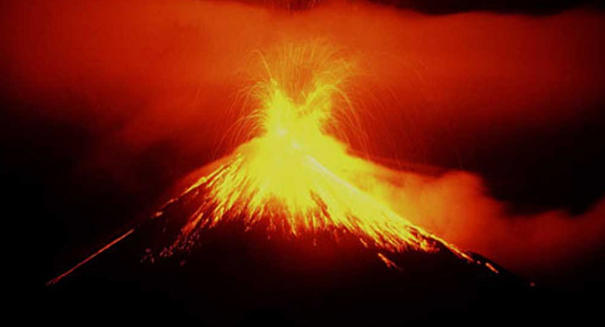
Exciting new discovery reveals causes of supervolcano eruptions.
For the first time, researchers have been able to show a link between the frequency and magnitude of volcanic eruptions, shedding some light on the supervolcano eruption mystery.
A supervolcano is a volcano capable of producing an eruption with a volume greater than 240 cubic miles, which is thousands of times larger than a normal volcanic eruption, according to the U.S. Geological Survey.
A research team was able to determine that super-eruptions have different causes than normal eruptions. Using numerical modelling and statistical techniques, they were able to figure out what causes the supervolcano eruptions.
Specifically they found that while small, more frequent volcanic eruptions are triggered by a process called magma replenishment, “The new research shows that larger, less frequent eruptions are caused by a different phenomenon known as magma buoyancy, driven by slow accumulation of low-density magma beneath a volcano,” according to the news release.
“Some volcanoes ooze modest quantities of magma at regular intervals, whereas others blow their tops in infrequent super-eruptions,” Professor Jon Blundy said in the release. “Understanding what controls these different types of behavior is a fundamental geological question.
Prof. Blundy believes their work shows that, “This behavior results from interplay between the rate at which magma is supplied to the shallow crust underneath a volcano and the strength of the crust itself. Very large eruptions require just the right (or wrong!) combination of magma supply and crustal strength.”
The study, titled, “Supervolcano eruptions driven by melt buoyancy in large silicic magma chambers” was carried out by an international team of researchers from Universities of Geneva, Bristol and Savoie and it will be published in today’s issue of Natural Geoscience.
Volcanic eruptions are difficult to predict but more is being learned about them. The latest discovery comes on the heels of another that also sheds light on what predictive factors precede volcanic eruptions.
In September of 2013, Yale researchers released a study also published in Nature Geoscience that identified the key signals of an imminent eruption. In that study, researchers found the before volcanoes tend to shake or tremor they undergo regular, repeated oscillations and gas release and that monitoring this activity is vital to understanding whether an eruption is imminent, according to the Yale news release.
The researchers of the Yale study proposed, “That these long, slow oscillations are due to magma gas waves rising up inside the volcanic conduit — the central “chimney” through which magma rises before an eruption. If a layer of magma in the conduit gets particularly bubbly, it will rise more rapidly and travel as a gas-rich pulse or wave. If the pulse is big enough, the gas will expand as it rises, and the pulse will grow. If it’s too big, it will just leak out as it expands, so the pulse won’t grow as well. If it’s too small, the weight of the magma will squeeze the gas and make the pulse shrink and decay.”
They found that those gas pulses had to be the right size in order to make it to the surface, and they had to cause cause oscillations in ground swelling and gas release. Their models matched the observations very closely.

Leave a Reply